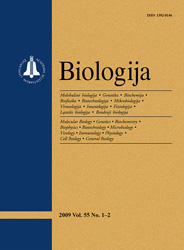 ISSN 1392-0146 ISSN 2029-0578 (online) |
2008 m. Nr. 4 Lipases in conversion of oils. Experimental screening of enzymes and substrates for biodiesel production
Lipases of different origin were screened for substrates and different reactions from the practical approach to search for the optimal conditions for biodiesel component production. The commercial lipases under analysis were shown to be specific to p-nitrophenyl fatty acid esters of medium chain length, although Lipolase100 LEX also showed a relatively high hydrolytic activity on p-nitrophenyl palmitate. The soluble Enterobacter aerogenes lipase was shown also to be the most active when hydrolysing medium-chain-length p-nitrophenyl fatty acid esters. The specificity of immobilized commercial lipases did not change as compared with soluble analogues. The immobilized Enterobacter aerogenes lipase showed no significant differences of activity towards p-nitrophenyl butyrate and medium-chain p-nitrophenyl fatty acid esters versus the attached enzyme on polyurethane and chitosan and also showed the highest hydrolytic activity on p-nitrophenyl caprylate as for soluble lipase. Enterobacter aerogenes lipase-catalyzed esterification of oleic acid with oleoyl alcohol was a long-lasting process still in progress after 91 hours. The lipase showed the highest catalytic activity when esterifying oleic acid with ethanol and 1.2-ethanediol. The enzyme slightly esterified the acid with 1.3-propanediol and was almost inactive for esterification with 2-hydroxyethyl ether. Enterobacter aerogenes lipase more efficiently hydrolysed camelina oil than rapeseed oil, considering the former to be an alternative source to be converted into biodiesel components. Methanolysis of rapeseed oil catalyzed by the lipase adsorbed on chitin was also a long-lasting process still in progress during 124 hours. The optimal glycerol-tricaprylate-to-methanol ratio was 1 : 1 for methanolysis of the substrate catalysed by Resinase HT lipase immobilized on a polyurethane support. The lipase was completely depressed at the ratio 1 : 3. Keywords: biodiesel, transesterification, lipases, immobilized enzymes |
Issues:
2011 - Vol.57 No. 1, No. 2, No. 3 2010 - Vol.56 No. 1-4 2009 - Vol.55 No. 1-2, No. 3-4 2008 - Vol.54 No. 1, No. 2, No. 3, No. 4 2007 - Vol.53 No. 1, No. 2, No. 3, No. 4 2006 No. 1, No. 2, No. 3, No. 4 2005 No. 1, No. 2, No. 3, No. 4 2004 No. 1, No. 2, No. 3, No. 4 2003 No. 1, No. 2, No. 3, No. 4 2002 No. 1, No. 2, No. 3, No. 4 2001 No. 1, No. 2, No. 3, No. 4 |